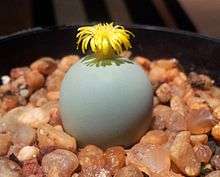Conophytum calculus
| Conophytum calculus | |
|---|---|
 | |
| Conophytum calculus with its flower open at night | |
| Scientific classification | |
| Kingdom: | Plantae |
| (unranked): | Angiosperms |
| (unranked): | Eudicots |
| (unranked): | Core eudicots |
| Order: | Caryophyllales |
| Family: | Aizoaceae |
| Genus: | Conophytum |
| Species: | C. calculus |
| Binomial name | |
| Conophytum calculus | |
Conophytum calculus is a small South African species of succulent plant of the genus Conophytum.[1]
Description
Rounded ball-shaped succulent plant, that divides to form dense clumps. The resemblance to pebbles is what got it its name ("calculus" is Latin for "pebble"). It produces yellow flowers in autumn, that open at night, and have the aroma of cloves.
The ball shape is formed from the plant's leaf-pair having fused entirely, leaving only a tiny slit at the top, where the flower and the succeeding leaf pair pushes through. The new leaf-pair forms inside the ball. When it is ready, the ball of the old leaf-pair shrivels and dries out, before it is split open by the new leaf-pair ball. The plants are extremely long-lived, and have been kept in captivity for over 50 years.
Distribution
Conophytums are all indigenous to the winter rainfall regions of southern Africa. Conophytum calculus is indigenous to the "Knersvlakte" region, in the far north-west of the Western Cape Province, South Africa. It also occurs as far north as Bitterfontein.
The "Knersvlakte" is a region of white, quartz pebble-fields. Therefore in spite of the semi-arid climate, the soil is typically quite cool (due to the reflective white of the quartz pebble-fields). The clove-scented flowers are pollinated by moths at night.
Cultivation
This species is relatively popular in cultivation, but requires specific winter-watering conditions.
They thrive in pots, in a mildly-acidic, coarse, extremely well-drained, soil-sand mix. In winter they can be lightly watered (from Spring right through to Autumn) and given bright morning light with afternoon shade. In summer they go dormant, and should be kept mostly dry and shaded.
The plant produces obvious wrinkles when it requires more water. It cracks and splits open when it receives too much water.
They can be propagated by cuttings, subdivision of clumps, or by seed.[2]
| Wikimedia Commons has media related to Conophytum calculus. |
References
Further reading
- Hammer,S.(2002) Dumpling and his wife: New views of the genus Conophytum EAE Creative Colour Ltd. ISBN 0-9539326-1-3.
- Hammer,S.(1993) The genus Conophytum : A Conograph Succulent Plant Publications, Pretoria. ISBN 0-620-17633-4.
- National Botanical Institute of South Africa.(1993) List of Southern African Succulent Plants Umdaus Press. ISBN 1-919 766-04-9